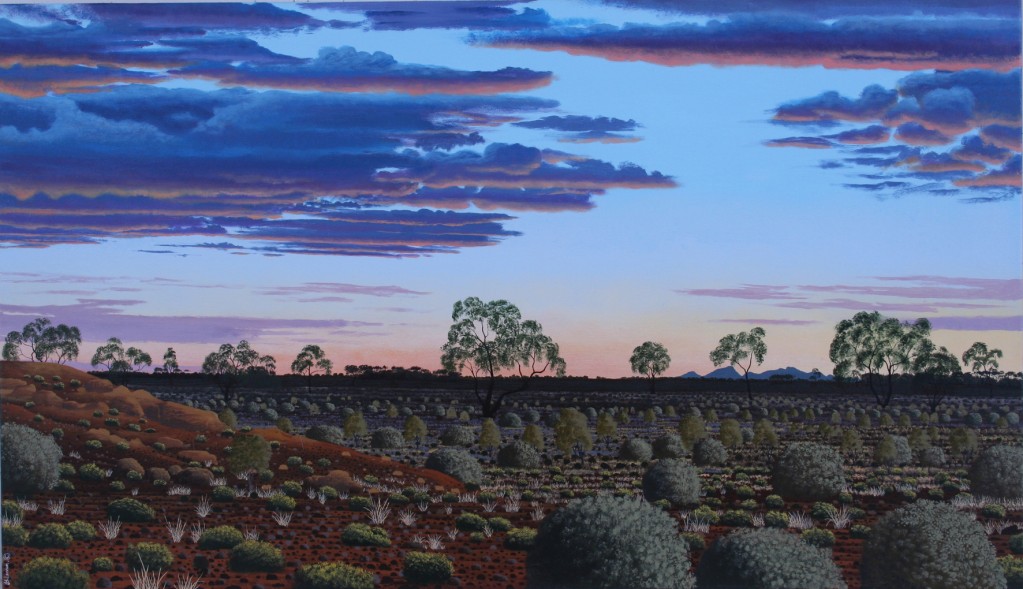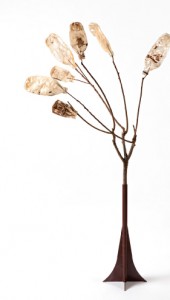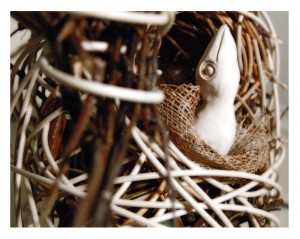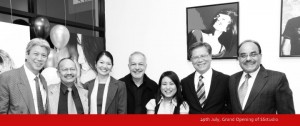RAW: Visual Art
RAW: SALA – Exhibition of Happiness – Kirsty Shadiac – Tin Cat Cafe – 4.5K
Aug 20th
Clearly one of the most successful exhibitions at this year’s SALA is that of returned local girl, Kirsty Shadiac and her most engaging images of children sharing moments of pleasure. Located at the quaint Tin Cat Cafe, the use of broad brushed white backdrops to the animated actions of the children simply but effectively captures them alone, in their own world, possessed only by their own thoughts and oblivious to what else is around them. And Kirsty has captured all manner of these moments, fiddling with fruit, hiding in boxes, playing hop scotch, in the boughs of a tree, fishing in a stream. All not only portray the innocence of that age but at the very least contentment and often rapturous joy of those moments.
Laughter, six children revelling in the world around them on a summer’s day encapsulates all the key features of the exhibition and is a standout work.
Her style is also unique in other respects – the black outlines to the motifs, the drips let loose to develop visual balance – and her smaller water colours also amply capture the mood of shady summer afternoons, such as her three part Little Red Boat series, displaying skills in an alternate form but without loss of impact.
Rather than being potentially criticised for attempting to cash in on images of children for starry eyed parents, Kirsty comes from a background of having worked with children professionally both in Sydney and locally, including those with disabilities, cancer and general sickness in all manner of institutions. That none of her paintings carry any shred of darkness inherent in those conditions is a tribute to her work and the children she has worked with.
Kryztoff Rating 4.5K
RAW: SALA – Bill Botten’s Abstract Paintings – The Maid – 4K
Aug 18th
 Since first exhibiting five years ago, Bill Botten’s work continues to develop with particular emphasis on single subjects or styles within his genre of artworks with that reflective mood. Even within this relatively small collection of 15 some major themes along these lines are explored. I shall mention three.
Since first exhibiting five years ago, Bill Botten’s work continues to develop with particular emphasis on single subjects or styles within his genre of artworks with that reflective mood. Even within this relatively small collection of 15 some major themes along these lines are explored. I shall mention three.
Some of Botten’s canvasses are now quite substantial, Field Hospital at over 3m in width and Flag of Unknown Country are examples but none of his ability to create an almost floating balance on them, a hall mark of his work, is lost. Then there is an increased intensity to much of his brushwork and motifs since his early days – multiple joined black circles or circular shapes dominate in this collection (eg Army of Country of Unknown Flag) while the concept of nationhood is fully explored in five pieces including Immigration Staten Island (above), almost a homage to Blue Poles or Pollacks’ works generally and (the aforementioned) Flag of Unknown Country which tempts immediate recognition before causing one to recoil to ponder its lineage.
While many exhibitions have works that sit on walls making no impact on their exhibiting space, at least two of Botten’s pieces work a treat in situ in their cosy, fire lit, secluded portions of The Maid – owners, take note, they may be a bonus acquisition for your establishment.
Finally, one of Bill’s most endearing qualities is to provide titles to his works that rather than being a self indulgence most clearly add to interpretation and identification of the subject matter which for abstract work is a rarity if not a novelty. More please.
Kryztoff Rating 4K
RAW: SALA – X-HIBIT By Simon Klobas – Gallery on Waymouth
Aug 17th
Simon Klobas is the force behind this initiative to have some of Adelaide’s young and upcoming artists exhibit before their peers in a relaxed club atmosphere – to enjoy art in an opening night spirit but without the art nobs. His first night certainly suggested the idea has legs.
Five artists were featured and for mine Ashleigh Abbott’s crisp, clean geometrically shaped bird series was the stand out. A coming together of Gould and Mondrian, her birds were often presented in mirror images with titles such as ‘love is two minds without a single thought’ that gave them a romance and familiarity that was most endearing.
Gretl Watson-Blazewicz presented three large oils, painted with a palette knife to give them a rough but energising texture, of the San Diego coastline, Venice Beach, Ca and a street scene in Vietnam. Their perspectives were very much of the postcard type view and but the works oozed a life beyond your standard post card image.
Lili Dare’s drawings included two set at specific moments of time, those instances where emotions or events gets indelibly marked in memory. The girl with the bare shoulder in 3.47pm was her highlight. Along a similar line were Seb Paynter’s images, taking old scratchy or hazy photographs and working them up into a unique picture. Seemingly a little clichéd at first, over time they came to enchant and draw curiosity.
As mentioned, this X-Hibit exhibition was on for just one night and that is the sad part giving prospective buyers no time to consider the works, especially in the full light of day. Hopefully next time Simon will be granted a longer leash by the Gallery on Waymouth proprietors.
RAW: SALA – Sudhira Shah – SSStudio – Rundle St, Kent Town – 4K
Aug 16th
Sudhira Shah is a photo journalist with a specialty, when confronted with set pieces, for family portraits. She has been based in Adelaide for around 12 months and her first Adelaide, seven piece, exhibition heralded the opening of her SSStudio in Rundle Street, Kent Town.
It has to be said family portraiture is hardly new, the Gainsborough Studios of this world have thrived on it for decades, but Shah brings a life and enjoyment to her finished works that leap from the paper, images of spontaneity that make you want to be like those featured.
Using either a (mostly) white washed background and floor or the same in black, families across generations are brought together to celebrate their existences as both humans and as families. This exhibition goes a step further by highlighting not only the cross generational aspects but also cross cultural combinations that also just happen to finish up in Adelaide. It speaks to that most unheralded of our great success stories of racial integration.
Two images stand out. In close-up, one eyed relief, Roshni and Shyam are a couple of an arranged wedding and who have come to Adelaide from the hilly slopes of Nepal. Fifi and daughters Tislisha and Phila are from the African Xhosa tribe, the same as Nelson Mandella. Both images ooze of life and their interconnection and seeming contentment with their lot in Australia. They are part of the pot pouri of life that Shah is able to capture brilliantly drawing on her own inter-cultural and travelling experiences.
Group Shot at Opening. artist 3rd from right.
RAW: SALA – Our Mob – Artspace / Fest Theatre – Till 5 Sept – 4K
Aug 13th
 Our Mob is a state-wide celebration of regional and remote South Australian artists. This is its fifth year and derives from a desire to develop a sustainable and dynamic indigenous arts industry, now enshrined in the Statewide Indigenous Community Artists Development (SICAD) program. This year’s exhibition features Ngarrindjeri artists from the Riverland and Coorong.
Our Mob is a state-wide celebration of regional and remote South Australian artists. This is its fifth year and derives from a desire to develop a sustainable and dynamic indigenous arts industry, now enshrined in the Statewide Indigenous Community Artists Development (SICAD) program. This year’s exhibition features Ngarrindjeri artists from the Riverland and Coorong.
There are perhaps two stand-out feature works that certainly warrant the time to visit. Major Sumner’s Tree Canoe sits in the midst of the works resting on sand on the floor. A Ngarrindjeri elder, Sumner describes his canoe as a homage to the tree from which it is cut, being more than 100 years old, and to children as an example of both technique and culture. It is certainly impressive and as clear as anything could be of the close inter-relationship between the land and its uses by indigenous communities for thousands of years.
Beaver Lennon’s Break of Dawn (attached above) is notable for two reasons. First, it is one of the few works on display clearly borne of white man styles and techniques, Jack Absalom would be proud of the gums and the spinafex. The heavy, dewy atmospherics of the work with the dark under sides of the clouds, tinged with the dawn’s crimsons, pose the question of whether this is about the on-coming of a cultural storm or the dawn of new, brighter day. The second notable feature is that this work won the inaugural SA Indigenous Acquisitive Art Award of $5000 (thanks to an anonymous donor) that sees the work go into the Adelaide Festival Centre’s Indigenous Art Collection.
Also of note is the exquisite brush work of Roger (Bushfire) Saunders in his Spirits of Change and the raw talent of 9 year old, Ella Ackland’s Snake Protector, an acrylic on bark work of a snake slithering for safety.
Finally, of considerable interest is Narelle Unmeopa’s Emu Egg. Her daughter’s Emu egg is also there, a brightly coloured collectible, but Narelle’s exhibits extraordinary craftsmanship being symbols left as shell after all else has been scraped and sanded away down to the finest skin or membrane before reaching the egg’s yoke – no paint applied.
Kryztoff Rating 4K
Image: Beaver Lennon, The Break of Dawn, acrylic on canvas, 2010
RAW: SALA Drop The Dust – Kouwenhoven and Worth – 4K
Aug 10th
 Drop The Dust By Pamela Kouwenhoven and Margaret Worth – Flinders Uni Art Museum (State Library) – Till 29th August
Drop The Dust By Pamela Kouwenhoven and Margaret Worth – Flinders Uni Art Museum (State Library) – Till 29th August
The role of dust in our lives and the decay that leads to becoming dust is well explored in this small exhibition of both two and three dimensional works by these South Australian artists. At the big end, stands a decaying, rusted and old rainwater tank, with detritus from the water held, its decay or role as a collecting vessel assembled at its base. At the other end are ‘dust domes’, six transparent bell jars with architectural models of domestic residences in them that are overwhelmed by dust and other waste that one would commonly expect to exhume from a vacuum cleaner.
In the middle, paintings or panels spread with red dust collected from the Amata Aboriginal settlement. The intensity of these panels give the viewer the opportunity to see them either as cross sections of an ancient outback soil profile or aerial views of a seemingly never ending desert. The whole makes one feel like you have been dropped into the yard of an outback station with domesticity available at short hand but beyond all existing at the whim of the elements.
This is a very Australian exhibition that takes a new look at a very well covered homage to our outback and our ability to survive in it.
Floor talks by the artists, this Saturday, 14th August, at 2pm.
Kryztoff Rating 4K
RAW: Waterhouse Nat History Art Prize – SA Museum Till 5th Sept – 4K
Aug 9th
The Waterhouse Natural History Art Prize commemorates the SA Museum’s first curator, Frederick George Waterhouse and this is its eighth year and already it has become Australia’s richest prize awarded for natural history or wildlife art.
There are three categories, paintings, works on paper and sculpture and objects, with a Youth competition also included.
What strikes one immediately upon entering is the great variety of the works and approaches, even within each category. None could accuse the 104 finalists (chosen from 684 entries) of attempting to pander to some preconceived notion of what the judges or even the viewing and buying public might be after. (This may stand as a contrast to competitions such as the Archibald Portrait Prize.)
This year’s overall winner is Nikki Main’s Flood Stones which appears as shiny mid-sized mineral infused rocks but is in fact blown glass with silt and powders to give a sense of silt, sediment and running water in order to celebrate the flood phase of the hydrological cycle. Some works are monuments to wild life such as Indiana James’ Restraint – Wedge Tailed Eagle, others far more political such as the Youth Prize winner, Tessa McDonnell’s Owl In Victorian Bell Jar and Terry Jackson’s Not So Different, a pencil sketch of hand that is part human and part primate.
With a purpose of celebrating the intricate and complex world of global biodiversity as well as encouraging excellence in natural history art, the Waterhouse 2010 competition is a success on all fronts.
Kryztoff Rating – 4K
RAW: SALA – Steve O’Connor – Return To Nest – Urban Cow Studio – 4K
Aug 6th
 No one could accuse Steve O’Connor’s Return to Nest exhibition as lacking focus; a huge 77 items are nearly all dedicated to the theme from tiny clay birds to one metre hanging cane nests, arrowheads in paper clay with marble oxide to chalk, charcoal and acrylic paint on large canvases. The creativity around the theme is remarkable and the patience and craftsmanship with which so many of the items are created a credit. Many look as if the materials worked with would not be straight forward, brittle yet requiring malleability – like the nests themselves and their purpose in life.
No one could accuse Steve O’Connor’s Return to Nest exhibition as lacking focus; a huge 77 items are nearly all dedicated to the theme from tiny clay birds to one metre hanging cane nests, arrowheads in paper clay with marble oxide to chalk, charcoal and acrylic paint on large canvases. The creativity around the theme is remarkable and the patience and craftsmanship with which so many of the items are created a credit. Many look as if the materials worked with would not be straight forward, brittle yet requiring malleability – like the nests themselves and their purpose in life.
The Urban Cow Studio is an ideal place for such an exhibition, being its own house of curios, for here in Return To Next those looking for anything from a wall painting to a quaint paperweight will find objects of interest. The cane hanging nests are fine pieces with titles that evoke the safe refuge nature of nests such as Looking Out on a Misty Morning and Killin’ Time in the Afternoon Rain and stand out in the exhibition not only for their size.
O’Connor’s paintings are far more abstract that his moulded work, many featuring nest like shapes perched on top of bended tree trunks. These are motifs that look they could be a collaboration between Tim Burton and Salvador Dali but they work as individual art pieces in and of themselves.
Well worth the visit and have your credit card handy.
Kryztoff Rating 4K
RAW: SALA Ann Newmarch – Flinders Uni Art Museum (State Lib) – 3K
Aug 4th
Cultural Pattern and Human Fragility By Ann Newmarch – Flinders Uni Art Museum (State Library) – Till 29th August
Ann Newmarch’s 25th solo exhibition comprises 16 works and opinion may well divide on their merits. To be sure they are complex, any one incorporating many motifs that span on one axis of thought cultural items like Afgham rugs, rosettes, Italian and Greek monuments and on the other images of war and death such as the silhouettes of rifles, the photo of Kim Phuc fleeing a napalm attack in the Vietnam war and a trader falling to his death from one of the twin towers on 9/11.
There is also a beauty about them in that they hang well together and can sustain individual curiosity as well filling a space on a wall. However, the repetition of the images across all 16 works and overall feel somewhat confound the individual and often distinct titles and commentary associated with each.
Newmarch speaks in the catalogue of how ‘these images grew bit by bit without much consideration for the big picture. I felt like I was dissolving into each area I altered or added (a bit like a quilt, the complexities of each stitch.)’ Janet Maughn speaks of ‘the messages appear not so obviously. These are pictures that reward close inspection of different parts of the picture surface; that hint at relationships and encourage the viewer to make connections across cultures, across time and across events.
Thus the divide on these works is either they are a hotch potch of icons that will resonate from one’s consciousness that holds together as complex and colourful or the trained eye will make out these connections of culture and war and tie them in with their titles. But if the artists didn’t seem to know where they were going, I am unsure why viewers should or would.
Kryztoff Rating 3K
RAW: European Masters: Staedel Museum – NGV – Till 10th Oct
Jul 28th
Continuing the great series of Melbourne Winter Masterpieces, this year’s European Masters features almost 100 works by 70 artists from the Staedel Art Museum in Frankfurt, one of Germany’s oldest and most respected museums. The works are here, exclusively to Melbourne, as a result of the host museum undergoing renovations.
What’s on offer is unlike most curated exhibitions, being works with a tight collective theme, but rather what it is, a selection of the Staedel’s permanent collection of some 2700 paintings, 600 sculptures and more than 100,000 prints and drawings. As such it has items from across two centuries, with a strong Germanic core and spanning all manner of styles. Unlike perhaps how the publicity posters feature it, this is not another Impressionists wonderland, with items from that genre limited to about a dozen. Nonetheless, real artistic treats await the visitor.
The exhibition opens with Tischbein’s Goethe in the Roman Campagna from 1786, perhaps paying homage to Frankfurt’s son, regarded by many as Germany’s finest author. Amongst the Impressionist works is the stand out Renoir, La Fin du Dejeuner, though just what its meaning is remains unclear. The only artist with a true focus throughout is Max Beckmann. Born in 1884, Beckmann was profoundly affected by his involvement in World War 1 that altered his traditional depictions to distortions of both figures and space. These changes and many of his self and other portraits are featured in their own room. His Double Portrait (1923) portraying the wife and the mistress of the then director of the Staedel is notable if nothing else for its audacious subject matter.
As a tour through styles across 200 years, European Masters stands on its own. It certainly begs the question what will the next 100 years produce to match the upheavals and development of forms of this era. But, as a result, visitors will need to maintain an open mind and not allow their own preferences to prejudge works or rooms. This is helped by copious notes on the audio guide that both explain the specific works as well as place paintings in their context of both the exhibition and art movements generally.
Another Melbourne art treat this winter.
Kryztoff Rating 4K
